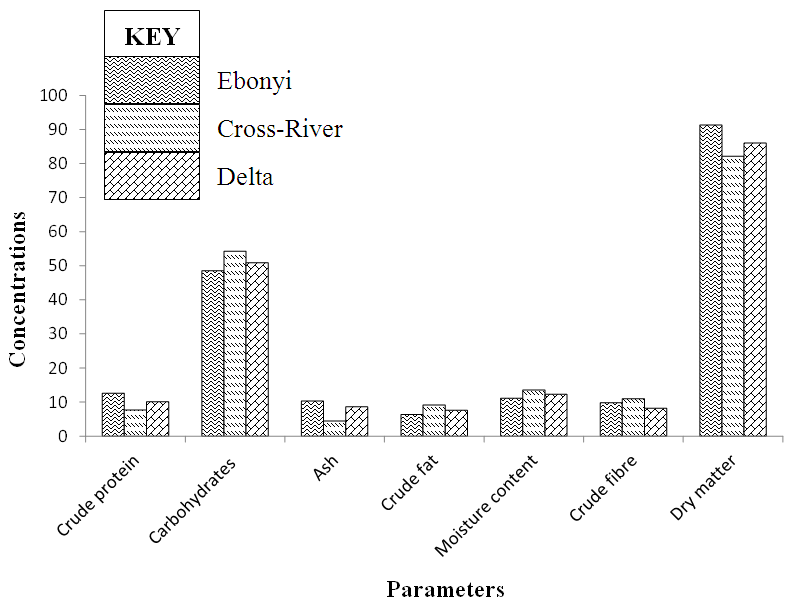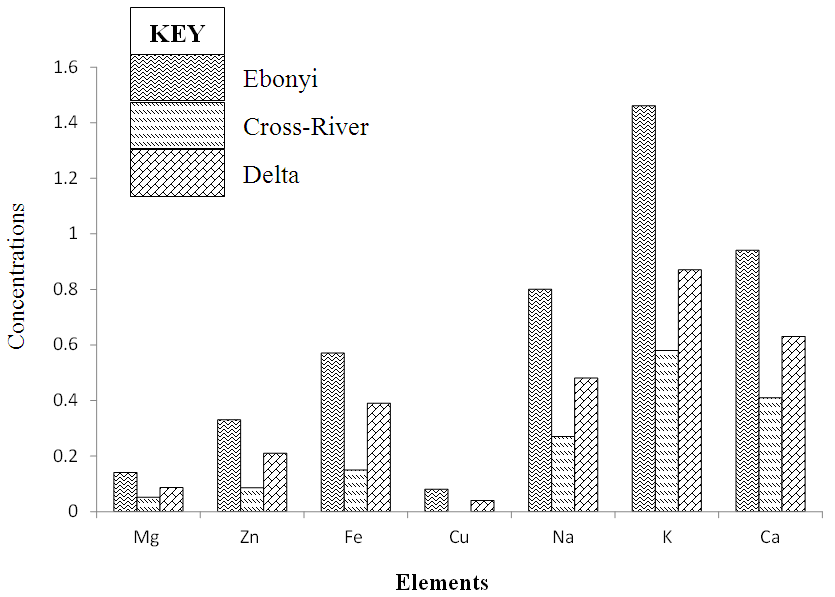-
Paper Information
- Paper Submission
-
Journal Information
- About This Journal
- Editorial Board
- Current Issue
- Archive
- Author Guidelines
- Contact Us
International Journal of Food Science and Nutrition Engineering
p-ISSN: 2166-5168 e-ISSN: 2166-5192
2018; 8(1): 10-14
doi:10.5923/j.food.20180801.03

Analysis of the Proximate and Mineral Contents in Uziza (Piper guineense) Seeds from Three Different States (Ebonyi, Cross-River and Delta) in the Southern Part of Nigeria
Okeke Onyeka1, Nwoye Benard2, Anya Ogbonnaya Ugwu2, Ezejiofor C. C.3
1Plastic Production Unit, Scientific Equipment Development Institute, Enugu, Nigeria
2Plastic Recycling Unit, Scientific Equipment Development Institute, Enugu, Nigeria
3Department of Microbiology, Caritas University, Enugu, Nigeria
Correspondence to: Okeke Onyeka, Plastic Production Unit, Scientific Equipment Development Institute, Enugu, Nigeria.
| Email: |  |
Copyright © 2018 Scientific & Academic Publishing. All Rights Reserved.
This work is licensed under the Creative Commons Attribution International License (CC BY).
http://creativecommons.org/licenses/by/4.0/

Studies were carried out to determine the proximate and mineral contents in Uziza seeds from three different states (Ebonyi, Cross-River, Delta) in the Southern part of Nigeria using established standard laboratory procedures. ANOVA showed that the proximate and mineral contents of uziza seeds in the three state of study differ significantly at p < 0.05. Of the three states, the proximate and mineral contents of the plant seeds from Ebonyi was the highest in crude protein, ash, dry matter, Mg, Zn, Fe, Cu, Na, K and Ca with values of 12.62%, 16.33%, 0.14ppm, 0.33ppm, 0.57ppm, 0.08ppm, 0.80ppm and 0.94ppm respectively. The plants seeds from Cross-River was the highest in carbohydrates, moisture content, crude fibre and crude fat with values of 54.31, 9.17, 13.61 and 11.04% respectively. The mineral compositions of the P.guineense seeds in the three locations decreased in the following order: K > Ca > Na > Fe > Zn > Mg > Cu. The seeds from the selected states contain the mineral elements in the following decreasing order: Ebonyi > Delta > Cross-River.
Keywords: Uziza (Piper guineense) seeds, Mineral contents, Proximate contents and Spices
Cite this paper: Okeke Onyeka, Nwoye Benard, Anya Ogbonnaya Ugwu, Ezejiofor C. C., Analysis of the Proximate and Mineral Contents in Uziza (Piper guineense) Seeds from Three Different States (Ebonyi, Cross-River and Delta) in the Southern Part of Nigeria, International Journal of Food Science and Nutrition Engineering, Vol. 8 No. 1, 2018, pp. 10-14. doi: 10.5923/j.food.20180801.03.
1. Introduction
- P. guineense is a spice plant from the family Piperaceae and from genius piper. It is a West African spice plant commonly called ashanti pepper (Okoye and Ebeledike, 2013). It is known as Uziza in Igbo and Iyere in Yoruba. Other common names are benin pepper, guinea pepper, false cubeb and Kale (Tapsell et al., 2006). The plants that provide the pepper are vines that grow up to 20m tall climbing up bole of trees by means of adventitious roots. It is a perennial plant that is characterized by heart shaped leaves and oval, petiole, alternate and 12cm long (Besong et al., 2016). The fruits of P. guineense occurs in clusters, small, reddish or reddish brown when ripe and black when dry (Nwankwo et al., 2014). The plant is native to tropical regions of Central and Western Africa and is semi-cultivated in countries like Nigeria, where it is found commonly in the southern part (Okwu 2001). It grows in evergreen rain forest, forest edges, usually in wet places, gallery forest along rocky rivers of an elevation of 750 – 1680m (Besong et al., 2016). There are more than 700 species of this plant throughout the tropical and sub-tropical regions of the world (Anyanwu and Nwosu, 2014). The different parts of the plant have been characterized and their chemical compositions determined and are used as therapeutic agents in minor ailments (Okwu, 2001).According to Daba et al., (2013), Piper guineense is a local spice made of dillapol, 5.8% piperine, elemicine and 10% myristicine and safrole and these chemicals exhibit bactericidal and anti-microbial effects on certain microorganisms. In traditional herbal medicine, the seeds of P. guineense are put into a variety of uses; for instance in some parts of Nigeria, the seeds are consumed by women after child birth to enhance uterine contraction for the expulsion of placenta and other remains from the womb (Mbongue et al., 2005). The seed and leaf extracts are capable of exhibiting a depolarizing neuromuscular activity in a concentration related manners (Ojinnaka et al., 2016).P. guineense have nutritional and non-nutritional factors which are responsible for its aroma, flavour and preservative properties and proximate analysis of the plant shows that it contains crude protein, fat carbohydrates and vitamins (Nwankwo et al., 2014). Okonkwo and Ogu (2014) reported that the plant contains vitamin C in considerable amount and this could aid the good health of teeth and gums and also promote healing.According to Anyanwu and Nwosu, (2004), P. guineense by its nature is aromatic and carminative and that it is a natural antioxidant, act as anti-inflammatory, anti-cancer and anti-pyretic agents.Memudu et al., (2015) studied the effects of dry fruits of P. guineense on male fertility parameters using adult sprague darhey rats. 200mg/kg of the extract was given to two groups of the rats for four weeks and eight weeks respectively. The result showed that the extract improved male reproductive functions, sperm motility, sperm function and testicular spermatogenesis. In essence, they recommended that the plant should be used for the treatment of male and female fertility problems especially those associated with hormonal secretions in humans. Based on the general usefulness and importance of the seeds of P. guineense, studies were carried out to determine its proximate and mineral contents in three selected states (Ebonyi, Cross-River and Delta) in southern parts of Nigeria.
2. Materials and Methods
- Sample collection: The seeds of uziza (P. guineense) were respectively purchased from major markets in the three selected states (Ebonyi, Cross-River and Delta) and were sorted to remove debris. The seeds were separated from their shells and washed with distilled water and subsequently oven-dried at 65°C for 4hours and milled into powder with blender. It was then stored in air tight containers until required for analysis.Proximate AnalysisThe seed samples were analyzed for crude protein, ash, crude fibre, crude fat, moisture and dry matter contents according to the method of AOAC, (2000) while carbohydrate content was determined by difference.Mineral Analysis: Magnesium, zinc, potassium, iron, copper, sodium and calcium were determined with flame atomic absorption spectrometer.Statistical Analysis The data obtained were subjected to analysis of variance (ANOVA) using SPSS version 18.0 for windows and the level of significance was taken up as p < 0.05.
3. Results and Discussion
- Table 1 shows that the crude protein content of uziza seeds from Ebonyi (12.62%) was significantly higher than that from Delta (10.4%) and Cross-River (7.67%).
|
 | Figure 1. Bar chart representation of the proximate composition of Uziza seeds from Ebonyi, Cross-River and Delta states respectively |
|
 | Figure 2. Bar chart representation of the mineral contents of uziza seeds from Ebonyi, Cross-River and Delta states respectively |
4. Conclusions
- The study shows that seeds of P. guineense from the three studied locations (Cross-River, Ebonyi and Delta) are good sources of protein, carbohydrates, fats and fibre and equally contain the essential elements such as calcium, potassium, zinc, potassium and iron required for healthy living in appreciable amounts.The order of decrease in mineral composition of uziza seeds in the three studied locations was: Ebonyi > Delta > Cross-River. This was attributed to differences in stage of maturity of the seeds, edaphic and climatic influences in the different locations.
 Abstract
Abstract Reference
Reference Full-Text PDF
Full-Text PDF Full-text HTML
Full-text HTML
